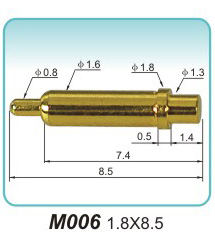source:Industry News release time:2020-11-11 Article author:sznbone Popular:POGO PIN
When choosing a probe, whether its characteristics can be touched while ensuring a certain degree of accuracy during contact is a key consideration for users. There are many types of probes, covering various shapes and different manufacturing materials.
The detector is a component of the coordinate measuring machine, which is mainly used to touch the surface of the measuring workpiece, so that the mechanical device of the measuring head can be shifted, and the signal trigger is generated. The mobile phone measures the data. Generally, the probe is composed of a rod and a gem ball. The spring thimble can determine the type and size of the probe to be used according to the characteristics of the required measurement. The rigidity of the measuring head and the shape of the measuring tip are required to be optimal during the measurement process.

Keep the length of the probe as short as possible. The greater the bend or offset of the probe, the lower the measurement accuracy will be. Therefore, it is best to use a short probe when measuring. There are few joints, and each time the probe is connected to the extension rod, new potential bending and deformation points are additionally introduced. Therefore, when using it, it is best to reduce the number of connections. The key also depends on the size of the ball. There are two main factors to make the club/ball gap large, thereby reducing the possibility of false triggering due to "sway". A larger ball diameter can weaken the unpolished test. The effect of appearance on accuracy.
When using a long rod and a long rod to measure, it is best not to use a proportional dynamic touch probe, because in this case the probe is prone to bending deformation, which will reduce the rigidity of the probe and the measurement accuracy. Stainless steel, tungsten carbide, ceramics and various special carbon fiber materials "Renisha Gefu". Ruby long materials are often hard, and the made probes have very little wear and density, so the quality of the needle tip is very small, which can prevent false triggering of the probe due to mechanical movement or vibration.
This simple ruby probe is more suitable for various test applications. The selected bars can be selected from a variety of materials, and the simple structure probe system covers industrial ruby bars with sphericity, and bars can be used. Using a relatively large ruby ball can reduce the influence of the surface roughness of the component to be tested.
The size of the sphere and the selection of the EWL of the probe depend on the size of the measured element. It is best to choose a large ruby probe sphere and as short a probe sphere as possible to ensure a large sphere interval to provide a more effective EWL. This method also uses other types of probes, such as those that promise elastic deformation. Their antennae are very small, and promise to use a combination of long probes and extension rods without significant loss of accuracy. The detection effective working length (EWL) is the change range of the ruby ball before the probe touches the measured element.
Read recommendations:
POGO PIN!RF Pogo Pin Production
AR/VR/MR product application pogopin magnetic suction charging connection
What is the function of pogopin connector in electronic industry